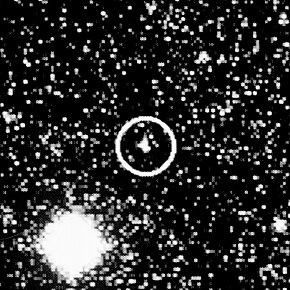
Back 15760 Albion Afrikaans 15760 ألبيون Arabic 15760 البيون (كويكب) ARZ 15760 Albion AST (15760) 1992 QB1 BE-X-OLD (15760) Albion Catalan (15760) Albion CE Albion (planetka) Czech (15760) 1992 QB1 Danish (15760) Albion German
 Long-exposure image of Albion (circled) taken by the European Southern Observatory in September 1992 | |
| Discovery[1][2] | |
|---|---|
| Discovered by | D. C. Jewitt J. X. Luu |
| Discovery site | Mauna Kea Obs. |
| Discovery date | 30 August 1992 |
| Designations | |
| (15760) Albion | |
| Pronunciation | /ˈælbiən/ |
Named after | Albion[3] (mythology by William Blake) |
| 1992 QB1 | |
| TNO[1] · cubewano[4][5] (cold)[6] distant[3] | |
| Orbital characteristics[1] | |
| Epoch 31 May 2020 (JD 2459000.5) | |
| Uncertainty parameter 3 | |
| Observation arc | 26.34 yr (9,621 days) |
| Aphelion | 47.042 AU |
| Perihelion | 40.809 AU |
| 43.925 AU | |
| Eccentricity | 0.07096 |
| 291.13 yr (106,334 days) | |
| 34.041° | |
| 0° 0m 12.188s / day | |
| Inclination | 2.1797° |
| 359.276° | |
| 0.7765° | |
| Physical characteristics | |
| 108 km[6] 167 km[4] | |
| 0.2 (assumed)[6] | |
| RR (red)[7] B–V=0.869±0.143[8] V−R=0.707±0.093[8] V−I=1.212±0.146[8] | |
| 23.3[9] | |
| 7.38±0.06[10] · 7.1[1] | |
15760 Albion (provisional designation 1992 QB1) was the first trans-Neptunian object to be discovered after Pluto and Charon. Measuring about 108–167 kilometres in diameter, it was discovered in 1992 by David C. Jewitt and Jane X. Luu at the Mauna Kea Observatory, Hawaii. After the discovery, they dubbed the object "Smiley" and it was shortly hailed as the tenth planet by the press.[11][12] It is a "cold" classical Kuiper belt object and gave rise to the name cubewano for this kind of object, after the QB1 portion of its designation.[13] Decoding its provisional designation, "QB1" reveals that it was the 27th object found in the second half of August of that year.[1] As of January 2018, around 2,400 further objects have been found beyond Neptune, a majority of which are classical Kuiper belt objects. It was named after Albion from William Blake's mythology.[14]
- ^ a b c d Cite error: The named reference
jpldatawas invoked but never defined (see the help page). - ^ Cite error: The named reference
IAUC5611was invoked but never defined (see the help page). - ^ a b Cite error: The named reference
MPC-objectwas invoked but never defined (see the help page). - ^ a b Cite error: The named reference
johnstonwas invoked but never defined (see the help page). - ^ Cite error: The named reference
Buiewas invoked but never defined (see the help page). - ^ a b c Cite error: The named reference
BrownListwas invoked but never defined (see the help page). - ^ Cite error: The named reference
Fulchignoni2008was invoked but never defined (see the help page). - ^ a b c Cite error: The named reference
Hainaut2012was invoked but never defined (see the help page). - ^ Cite error: The named reference
AstDyswas invoked but never defined (see the help page). - ^ Cite error: The named reference
Benecchi2011was invoked but never defined (see the help page). - ^ Collander-Brown, S.; Maran, M.; Williams, I. P. (2000-10-11). "The effect on the Edgeworth-Kuiper Belt of a large distant tenth planet". Monthly Notices of the Royal Astronomical Society. 318 (1): 101–108. Bibcode:2000MNRAS.318..101C. doi:10.1046/j.1365-8711.2000.03640.x. ISSN 0035-8711.
- ^ Coote, Roger. / (August 2008). The earth. London. ISBN 9781842399491. OCLC 671197414.
{{cite book}}: CS1 maint: location missing publisher (link) - ^ Dr. David Jewitt. "Classical Kuiper Belt Objects". David Jewitt/UCLA. Archived from the original on November 4, 2013. Retrieved July 1, 2013.
- ^ "(15760) Albion = 1992 QB1". IAU Minor Planet Center.